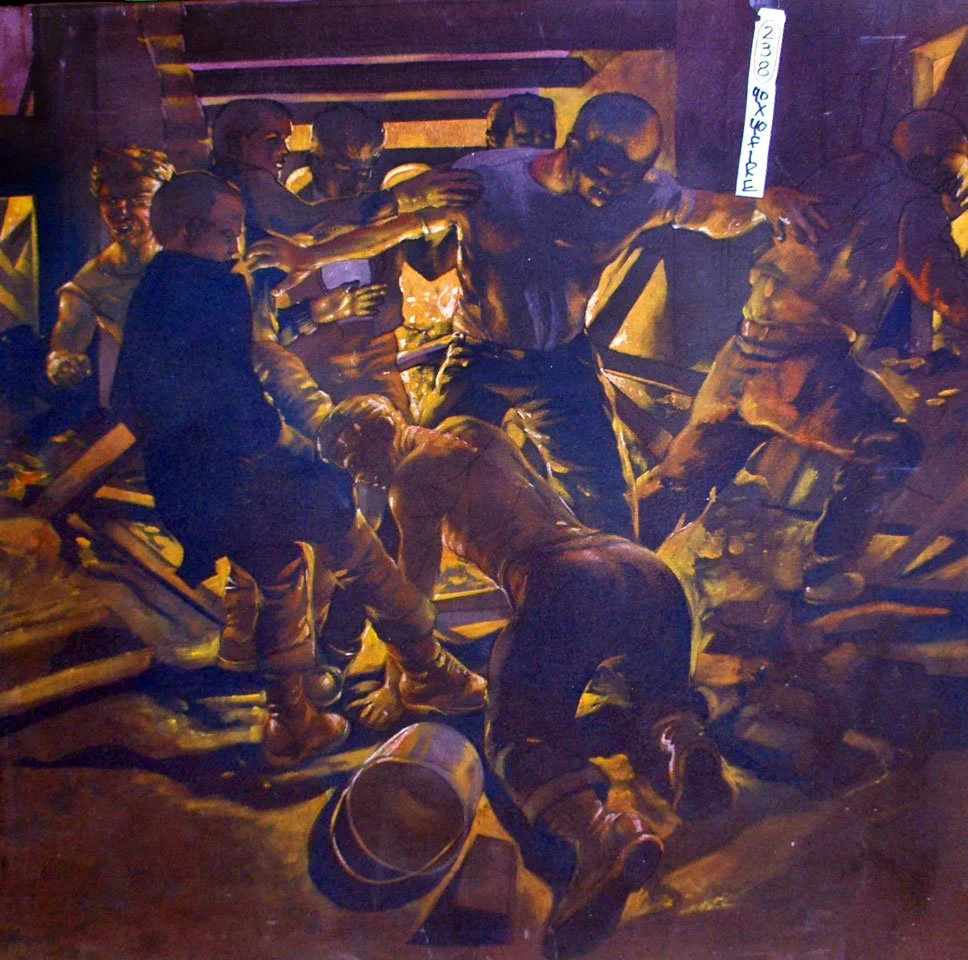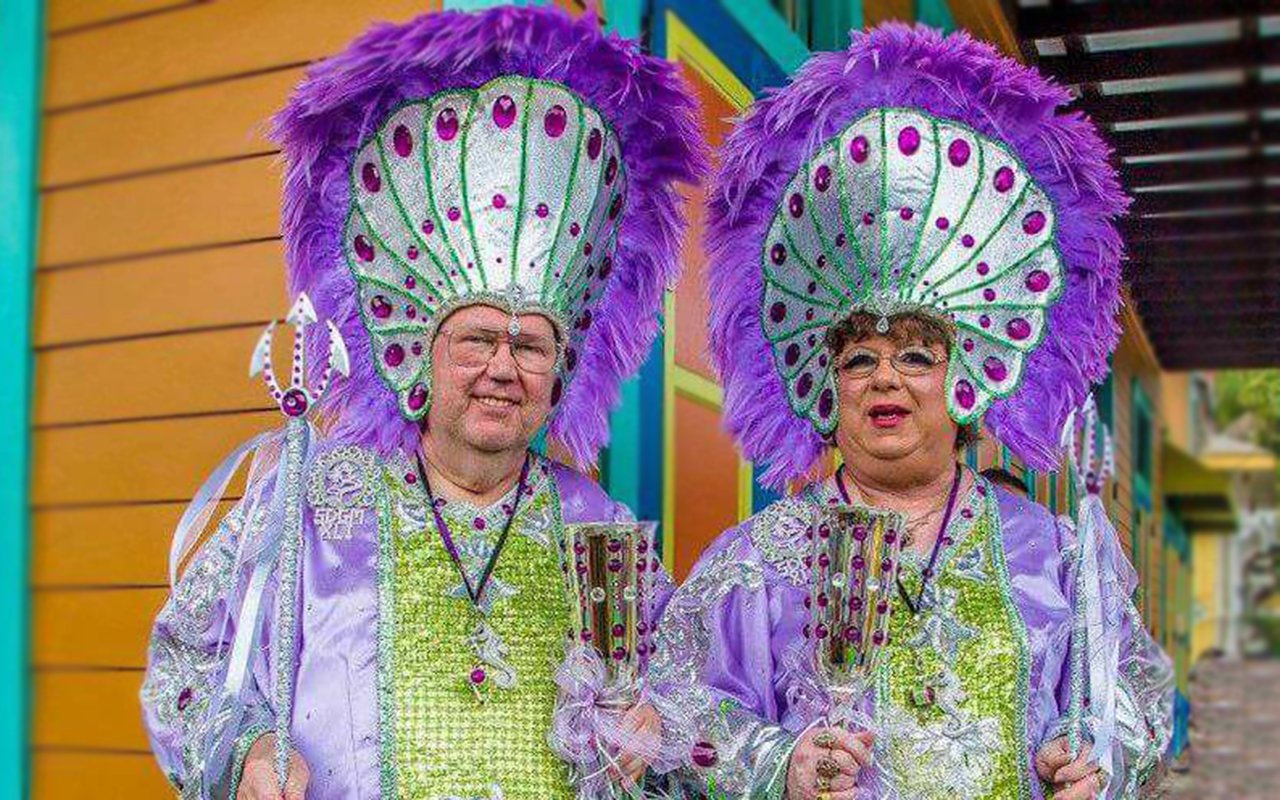A Look Inside: Rainbow Fleur de Lis
The 1977 Anita Bryant protest that helped galvanize the New Orleans LGBT community. Photograph copyright Owen Murphy, with permission
August 2025Frank Perez's new book on New Orleans LGBT+ history bears witness to the value of local journalism – especially when covering minority communities.
-by Claude Summers
This column is underwritten in part by Karen Hinton and Howard Glaser
In the United States, organizing for gay and lesbian rights began soon after World War II and intensified with the homophile movement of the 1950s. But the Stonewall Rebellion in Greenwich Village on the weekend of June 27-29, 1969 is the event that has come to signify the beginning of the modern gay rights movement.
Although there had been resistance to police oppression by gay men, lesbians, and trans people in San Francisco in 1966 and in Los Angeles in 1967, the riots in New York are widely seen as marking a critical change of consciousness on the part of queer people – a change that made possible a large-scale movement for equal rights.
News of the Stonewall riots released pent-up energy within the LGBT+ communities and a new more confrontational activism was born, one based on sometimes confusing and competing ideologies, which might best be summed up as the expression of a newly embraced pride – an insistence that homosexuality is a normal variation in human sexuality that needs to be respected and even celebrated.
After the Stonewall Rebellion, the newly energized LGBT+ movement spawned a huge number of political and community organizations and publications. In the year between the riots and their first commemoration in 1970, groups such as the Gay Liberation Front and Gay Activists Alliance were established in New York, San Francisco, and Los Angeles.
Organizations also sprang up in Midwestern cities such as Chicago and Detroit, and even in medium-size and small cities across the country, where they helped nurture a movement that would eventually achieve major steps toward equal rights for all.
The gay liberation movement even affected the notoriously apolitical queer community in New Orleans. Just weeks after the Stonewall riots, a chapter of the Gay Liberation Front was formed in the city by activists Lynn Miller and David Solomon.
This chapter is best remembered for a demonstration in front of City Hall in January 1971 protesting police harassment. The protest received some coverage in the Times-Picayune but was mostly ignored. The group, like many others in the history of New Orleans gay activism, soon disbanded.
As Frank Perez astutely observes in his new book, Rainbow Fleur de Lis: Essays on Queer New Orleans History, despite a thriving LGBT+ community in New Orleans, political activism has never generated the excitement and activity here that it has in other major metropolitan areas.
"New Orleans is not a radical city and our gay forefathers always preferred to organize socially rather than politically."
The pride that the Stonewall Rebellion awakened affected New Orleans no less than other cities, but it took a significantly different form here. It can be seen not in the success of political organizations, but rather in a rich history of gay and lesbian bars and entertainment venues, in gay Mardi Gras krewes, and in events such as Southern Decadence – all of which are chronicled in Perez's immensely useful book.
A collection of eighty-five brief essays (five of which were originally published in French Quarter Journal), Rainbow Fleur de Lis is a welcome addition to the growing number of books that explore the complicated experience of LGBT+ people in New Orleans.
Perez's anthology surveys significant events, people, and institutions central to understanding the contributions and difficulties faced by queer people in the city.
Although Rainbow Fleur de Lis is published by the University Press of Mississippi, it is not a scholarly book. Rather it is a compilation of accessible journalistic pieces that report on events and individuals who helped shape New Orleans gay culture.
Eighty of the pieces were published as columns in Ambush Magazine, "a tabloid bar rag," that was originally distributed mostly in gay bars and now exists as an online publication. While such tabloids are often dismissed as ephemeral, or valued only as documents of a particular time and place, Perez's pieces merit collecting and thereby reaching a wider audience.
In fact, his book is an eloquent testament to the value of local journalism and local history, especially for marginalized communities, whose issues and concerns are often ignored by mainstream media.
The arrangement of Rainbow Fleur de Lis into a series of sections, such as "Gay Carnival," "Gay Bars and Spaces," "Activism," "Organizations," and "Preservation," allows the individual pieces written over a twelve-year period to cohere into an overview that is greater than the sum of its parts.
Perez, the cofounder and current executive director of the LGBT+ Archives Project of Louisiana and the author of several books about gay life in New Orleans, is uniquely qualified as an observer and reporter on a community that he has researched carefully and knows intimately.
Frank Perez, photo by Ellis Anderson for French Quarter Journal
The history of gay activism in New Orleans is haunted and to some extent shaped not by Stonewall but by two other events, the Up Stairs Lounge fire of 1973 and the 1977 protest against Anita Bryant.
The tragedy of the Up Stairs Lounge fire, in which 32 people were killed and others injured, was compounded by the cruelty of the media, the indifference of the NOPD, the silence of elected officials, and the downright hatefulness of many members of the religious establishment. The arson was at the time the deadliest crime against gay men and lesbians perpetrated in the United States.
The disgraceful reaction to the fire by city officials and most clergy exposed the bigotry that lay below the grudging tolerance that gay men and lesbians had won in the city in the early 1970s. It motivated a flurry of activism, but one that was short-lived.
As Perez remarks, "the fire should have been a southern Stonewall – a wake-up call that sparked a movement. But it wasn't."
That would not come until four years later.
Yet the Up Stairs Lounge fire remains in our collective consciousness and has been regularly commemorated, most recently by city officials and religious leaders who acknowledge the humanity of LGBT+ people. It is fair to say that the varied reactions to the fire serve as a barometer by which to measure the progress of the gay community in New Orleans from being held in disdain to achieving a measure of respect.
Painting of the Up Stairs fire by Philip Core, with permission from Tom of Finland Foundation. Read “Philip M. Core: Torchbearer for Artistic Freedom"
In the early 1970s, the movement for equal rights made some significant gains. The American Psychiatric Association removed homosexuality from its list of mental disorders. Some 40 communities across the country adopted anti-discrimination ordinances.
And several openly gay and lesbian political candidates achieved office, most notably in San Francisco, where after multiple bids for office Harvey Milk was finally elected to the city's Board of Supervisors and quickly became a national figure.
But these early successes soon sparked a backlash exemplified by the emergence of the New Right, which in an effort to reverse the progress of the gay rights movement and restore "family values" perpetuated harmful stereotypes of LGBT+ people as inherently criminal, sick, and dangerous to children.
The most pivotal of these attacks came in Florida in 1977, when singer, television personality, and conservative Christian Anita Bryant spearheaded the "Save Our Children" campaign against an anti-discrimination ordinance that had been passed by the Dade County Board of Supervisors.
Despite resistance from the movement and a national boycott of Florida orange juice – one of the products Bryant represented in commercials – the ordinance was overwhelmingly repealed. Soon after her victory, Bryant announced a national crusade to save the country from homosexuality.
The very first concert Bryant gave after her victory in Miami was in New Orleans. In response to her scheduled appearance at Municipal Auditorium, local activists Alan Robinson, Bill Rushton, and Ann Gallmeyer quickly put together a coalition of fifteen groups, including nine gay Mardi Gras krewes, to sponsor a protest in Jackson Square on June 18, 1977.
Activist and editor Bill Rushton at his desk in the office of the Vieux Carré Courier in the 1970s, photo by Owen Murphy
The organizers invited some nationally known figures to speak at the rally, including Frank Kameny, now recognized as the father of the gay rights movement, and Sgt. Leonard Matlovich, a Vietnam War veteran who had been discharged from the U.S. Army for coming out.
Expectations for attendance were not high, so the organizers were astonished as thousands poured into Jackson Square to make a statement against the discrimination and defamation personified by Bryant.
After the rally, the crowd marched through the Quarter, cheered by residents who had decorated their balconies for the occasion. One of the largest civil rights demonstrations in the city's history, it marked a turning point in the trajectory of activism in New Orleans.
Photo of the 1977 rally that appeared in the Vieux Carré Courier, photograph copyright Owen Murphy, with permission
1977 rally against Anita Bryant, photograph copyright Owen Murphy, with permission
Whether Anita Bryant knew it or not, something had changed in the hearts and minds of the marchers, people whom she had denigrated as "garbage." She may have inspired the so-called Moral Majority, but she also unintentionally ignited a hunger for justice in the very people she despised.
Ultimately, her crusade ended in defeat, with her career in shambles.
But Perez's book doesn't dwell on the villains in LGBT+ history, though he does document the "climate of hostility" toward gay people in the 1950s – including the murder of tour guide Fernando Rios by Tulane University students who set out to "roll a queer" in the French Quarter.
Rather, Perez most often celebrates the heroes and heroines of the community – individuals like lesbian bar owner Charlene Schneider, activists Stewart Butler and Alfred Doolittle, and preservationist and philanthropist William Ratcliffe Irby.
Stewart Butler by Vince Santiago, with permission
The most affecting of the tributes to LGBT+ heroes are the ones commemorating Rip and Marsha Naquin, to whom the book is dedicated. For thirty-five years, Rip was the publisher of Ambush Magazine and Marsha his faithful companion.
Rip and Marsha served as Grand Marshals of Southern Decadence in 2015, photo courtesy Ambush Magazine
"Together," Perez writes, "they were a bright star in the gay French Quarter galaxy." The first couple to enter into a civil union in New Orleans, they were also pillars of the LGBT+ community, famous for their generosity and philanthropy.
Readers may wish that Rainbow Fleur de Lis contained more information about Black LGBT+ history and about the long – and sometimes bitter – struggle for an anti-discrimination ordinance in New Orleans. Nevertheless, the book is a rich and valuable contribution to queer New Orleans history.










